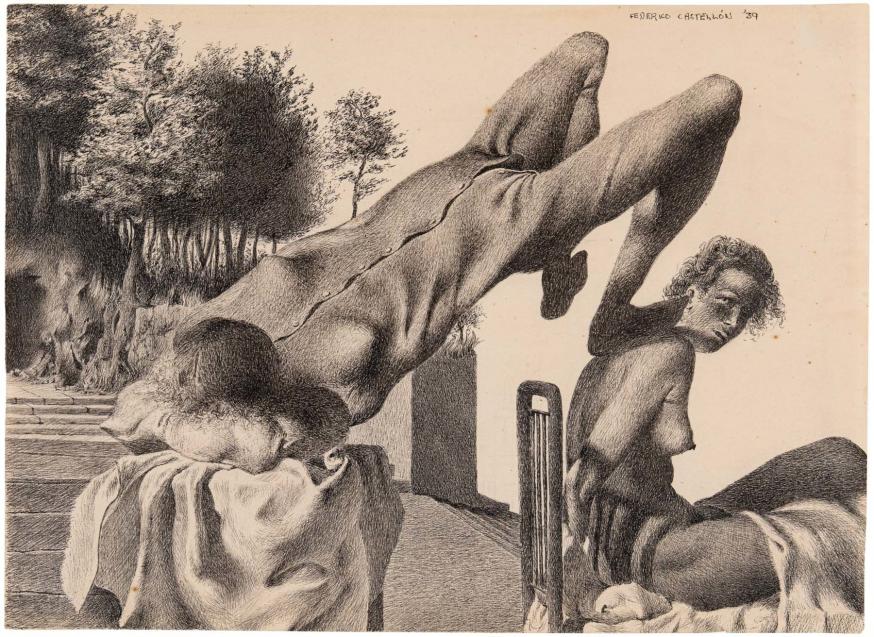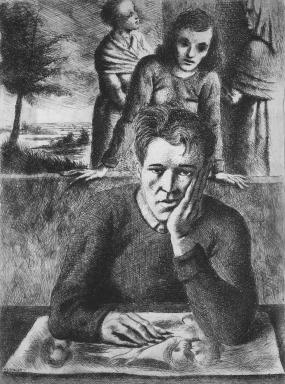Federico Castellon
1914–1971


Federico Castellon, Self-Portrait, 1942; Collection of Syracuse University, Syracuse, NY
All artworks displayed above are currently available. To inquire about additional works available by this artist, please contact the gallery.
Biography
An artist is in his head and we're not interpretive, we're creative.
Born in Alhabia, a city in Almería, Spain, to a family of seven children, Federico Castellon (1914-1971) lived in Barcelona until 1921, when his parents moved the family to Flatbush, Brooklyn. Speaking little English, Castellon encountered difficulties when attempting to adapt to his new setting; he was often the subject of ridicule among his classmates due to his foreigner status, and his struggle to learn English resulted in him being held back in school for two years. Castellon turned to drawing as a coping mechanism, becoming consumed by the creative process for hours at a time. As a teenager he often visited museums in the city to observe the works of European Old Masters; he was not exposed to modern art until his art teacher at Erasmus Hall High School, who strongly encouraged his drawing practice, introduced him to the works of Cézanne and Picasso. Shortly after graduating, he completed a mural for the school that drew enough critical attention that it was exhibited in New York at Raymond and Raymond Galleries before being permanently installed in the school.
Though the Surrealist movement did not become widely known among American audiences until 1936, when the Museum of Modern Art opened Alfred Barr’s landmark exhibition Fantastic Art, Dada, and Surrealism, Castellon had already cultivated a group of mature surrealistic drawings by the time he graduated high school in 1933. These works garnered the attention of Diego Rivera, to whom Castellon was introduced by a mutual friend when they attended a lecture the Mexican muralist gave on his (now destroyed) Man at the Crossroads murals in Rockefeller Center. Rivera took an immediate interest in Castellon’s work, bringing his drawings to the attention of Weyhe Gallery in New York; they subsequently gave Castellon his first solo exhibition in late 1933, when the artist was only eighteen. Rivera was so impressed with Castellon that he also began writing letters to the Spanish Minister of Education on his behalf, persuading the Spanish Republic to award the young artist, who lacked the resources to attend college, a government fellowship to study art in Europe for four years. In 1934, Castellon left New York to study painting and printmaking in Paris and Madrid.
In Europe Castellon befriended many of the avant-gardists who made European cafés lively places for intellectual discussion while pursuing his artistic training. The artist’s return to Spain also caused forgotten memories from his childhood to resurface, an unexpected experience that would have a profound effect on his art. “I think the great moving thing was my revisiting Spain and awakening all sort of strange things that came up,” he recalled, “like finding I had a soul, because these memories became real all of a sudden… And my early days, my Surrealism was mostly, I felt, a kind of poetic mysticism…I always meant it as a kind of poetic mysticism.”[1] The uncertain relationship between dream, memory, and reality would become a central theme in Castellon’s imagery. In 1936, the Spanish Civil War broke out, bringing an abrupt end to the artist’s studies and prompting an early return to New York. Weyhe Gallery opened Castellon’s second solo exhibition later in 1936, and he began to experiment with lithography and printmaking techniques he had learned in Europe. In both 1937 and 1938, his work was included in the annual survey of contemporary art at the Whitney Museum of American Art and, in 1939, he was invited to participate in Yaddo, an artist residency and retreat in Saratoga Springs, New York. The following year he was awarded the first of two Guggenheim Fellowships that he would receive in his career; the second was awarded in 1950.
Though critics labeled him a surrealist, Castellon initially thought of himself as a romantic; he cultivated a keen interest in poetry, especially that of Charles Baudelaire, Edgar Allan Poe, and William Blake, and stated that his early artistic influences included Rodolphe Bresdin, James Ensor, and Edvard Munch. Castellon remained an avid reader for the rest of his life, expanding his interests to psychology and philosophy. After becoming a US citizen in 1943, he was drafted into the army and eventually sent to China with the OSS. The decade following his military service was also defined by travel; he used the funds from his second Guggenheim fellowship to visit Italy, and in the late 1950s moved his family to Paris and Madrid for a brief period. He also began his teaching career during these years and took on commissions from American periodicals, most notably Life magazine. Though he worked in virtually every media, Castellon remains best known for his graphic works on paper, particularly his masterful body of etchings.
Works by Castellon may be found in museum collection across the US and Europe, including the Ackland Museum of Art, The University of North Carolina at Chapel Hill; Amon Carter Museum of American Art, Fort Worth, TX; Art Institute of Chicago, IL; Blanton Museum of Art, University of Texas at Austin; British Museum, London; Brooklyn Museum, NY; Buffalo AKG Art Gallery, Buffalo, NY; Cincinnati Museum of Art, OH; Cleveland Museum of Art, OH; Columbus Museum of Art, OH; Grinnell College Museum of Art, Grinnell, IA; Harvard Art Museums, Cambridge, MA; Harwood Museum of Art, Taos, NM; High Museum of Art, Atlanta, GA; Hood Museum of Art, Dartmouth College, Hanover, NH; Hunter Museum of American Art, Chattanooga, TN; Indianapolis Museum of Art, IN; Israel Museum, Jerusalem; Jordan Schnitzer Museum of Art, University of Oregon, Eugene; Joseph Allen Skinner Museum at Mount Holyoke College; Kalamazoo Institute of Arts, WA; La Salle University Art Museum, Philadelphia, PA; Legion of Honor, Fine Arts Museums of San Francisco, CA; Los Angeles County Museum of Art, CA; Mead Art Museum at Amherst College, MA; Minneapolis Institute of Art, MN; Mount Holyoke College Art Museum, South Hadley, MA; Museum of Fine Arts, Boston, MA; Museum of Modern Art, New York, NY; Museo Nacional Centro de Arte Reina Sofia, Madrid; National Gallery of Art, Washington, DC; Nelson-Atkins Museum of Art, Kansas City, MO; Pennsylvania Academy of the Fine Arts, Philadelphia, PA; Philadelphia Museum of Art, PA; Portland Art Museum, OR; Princeton University Art Museum, NJ; Rhode Island School of Design Museum, Providence, RI; San Diego Museum of Art, CA; Seattle Art Museum, WA; Sheldon Museum of Art, University of Nebraska-Lincoln; Smith College Museum of Art, Northampton, MA; Smithsonian American Art Museum, Washington, DC; Syracuse University Art Museum, NY; Tacoma Art Museum, WA; Weatherspoon Art Museum, Greensboro, NC; and the Whitney Museum of American Art, New York, NY.
Michael Rosenfeld Gallery LLC represents the Estate of Federico Castellon.
[1] Oral history interview with Federico Castellon, 1971 April 7-14, Archives of American Art, Smithsonian Institution. http://www.aaa.si.edu/collections/interviews/oral-history-interview-federico-castellon-5452 (Accessed September 2021).
Gallery Exhibitions
Publications

